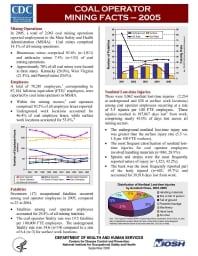Mining Publication: Coal Operator Mining Facts - 2005
Original creation date: September 2008
Authors: National Institute for Occupational Safety and Health
NIOSHTIC2 Number: 20034742
Pittsburgh, PA: U.S. Department of Health and Human Services, Public Health Service, Centers for Disease Control and Prevention, National Institute for Occupational Safety and Health, DHHS (NIOSH) Publication No. 2007-150, 2007 Sep; :1-2
Mining Operations: In 2005, a total of 2,063 coal mining operations reported employment to the Mine Safety and Health Administration (MSHA). Coal mines comprised 14.1% of all mining operations. Bituminous mines comprised 92.6% (n=1,911) and anthracite mines 7.4% (n=152) of coal mining operations. Approximately 70% of all coal mines were located in three states: Kentucky (28.0%), West Virginia (21.8%), and Pennsylvania (20.6%). Employees: A total of 78,281 employees, corresponding to 87,184 full-time equivalent (FTE) employees, were reported by coal mine operators to MSHA. Within the mining sectors, coal operators comprised 30.2% of all employee hours reported. Underground work locations accounted for 46.4% of coal employee hours, while surface work locations accounted for 53.6%. Fatalities: Seventeen (17) occupational fatalities occurred among coal operator employees in 2005, compared to 23 in 2004. Fatalities among coal operator employees accounted for 29.8% of all mining fatalities. The coal operator fatality rate was 19.5 fatalities per 100,000 FTE employees. The underground fatality rate was 34.6 (n=14) compared to a rate of 6.4 (n=3) for surface work locations. Nonfatal Lost-time Injuries: There were 3,062 nonfatal lost-time injuries (2,234 at underground and 828 at surface work locations) among coal operator employees occurring at a rate of 3.5 injuries per 100 FTE employees. These injuries resulted in 197,867 days lost from work, comprising nearly 43.0% of days lost across all mining sectors. The underground nonfatal lost-time injury rate was greater than the surface injury rate (5.5 vs. 1.8 per 100 FTE workers). The most frequent classification of nonfatal lost-time injuries for coal operator employees involved handling materials (n=886; 28.9%). Sprains and strains were the most frequently reported nature of injury (n=1,323; 43.2%). The back was the most frequently reported part of the body injured (n=602; 19.7%) and accounted for 39,918 days lost from work.

NIOSHTIC2 Number: 20034742
Pittsburgh, PA: U.S. Department of Health and Human Services, Public Health Service, Centers for Disease Control and Prevention, National Institute for Occupational Safety and Health, DHHS (NIOSH) Publication No. 2007-150, 2007 Sep; :1-2
- Coal and metal/nonmetal mining facts - 2008
- Coal and Metal/Nonmetal Mining Facts - 2008 (HTML)
- Coal Contractor Mining Facts - 2001
- Coal Contractor Mining Facts - 2002
- Coal Contractor Mining Facts - 2003
- Coal Contractor Mining Facts - 2004
- Coal Contractor Mining Facts - 2005
- Coal Contractor Mining Facts - 2006
- Mining Fact Sheets
- Rib Falls: A Major Ground Control Issue